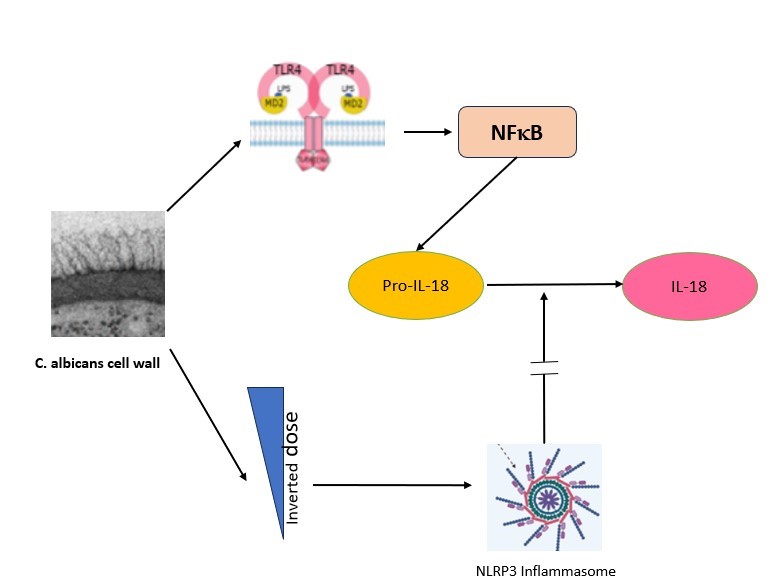The NLRP3 Inflammasome-Independent IL-18 Elevation Induced by Candida Albicans Cell Wall
DOI:
https://doi.org/10.48048/tis.2023.6888Keywords:
IL-18, NLRP3-inflammasome, Macrophage, C. albicans cell wall, Wistar ratAbstract
Objective: IL-18 has a significant role in host defense and pathogenesis of many inflammatory diseases. IL-18 production initiates if a particular PRR of innate immune cell binds specific PAMP, including O-linked mannan, a Candida albicans cell wall component. The binding of these PAMPs by TLR4 activates the intracellular signal pathway and activates NFkB to induce the production of pro-IL-18. Pro IL-18 undergoes breakdown to IL-18 active by the most common enzyme, caspase-1. Caspase-1 is the result of NLRP3 inflammasome activation. This study aimed to prove that the Candida albicans cell wall can induce IL-18 production and explore the role of NLRP3 inflammasome in that process. Methods: The Male Wistar rats were injected with 8 mg/kg BW/day and 16 mg/kg BW C. albicans cell wall intraperitoneally on 5 consecutive days in 2 periods with 23 days intervals between periods. Rats were sacrificed 24 h after the end of treatment. Expressions of NLRP3 inflammasome of intraperitoneal macrophages were measured by flow cytometry, and the level of IL-18 in blood plasma was measured with the ELISA technique. Results: IL-18 significantly increased in groups injected with 16 mg/kg BW/day but not those with 8 mg/kg BW/day. The expression of NLRP3 inflammasome was significantly increased in the group injected with 8 mg/kg BW/days C. albicans cell wall but not in the group injected with 16 mg/kg BW/days. Regression analysis showed that the increasing level of IL-18 was dependent on the C albicans cell wall dose but independent of the NLRP3inflamassome expression. The NLRP3-inflammasome expression did not depend on C albicans cell wall dose. Conclusions: C. albicans’ cell wall can increase the IL-18 plasma blood level, and the production of IL-18 is independent of NLRP3-inflammasome activation.
HIGHLIGHTS
- C. albicans cell wall induces IL-18 plasma levels that can cause inflammatory diseases
- C. albicans cell wall induces NLRP3-inflammasome in small doses but not in high dose
- The elevation of IL-18 is independent of the expression of NLRP3-inflammasome on the macrophage
GRAPHICAL ABSTRACT
Downloads
Metrics
References
D Boraschi and CA Dinarello. IL-18 in autoimmunity: Review. Eur. Cytokine Netw. 2006; 17, 224-52.
G Kaplanski. Interleukin-18: Biological properties and role in disease pathogenesis. Immunol. Rev. 2018; 281, 138-53.
J Talapko, M Juzbašić, T Matijević, E Pustijanac, S Bekić, I Kotris and I Škrlec. Candida albicans-the virulence factors and clinical manifestations of infection. J. Fungi 2021; 7, 79.
N Yapar. Epidemiology and risk factors for invasive candidiasis. Therapeut. Clin. Risk Manag. 2014; 10, 95-105.
C Bourgeois and K Kuchler. Fungal pathogens-a sweet and sour treat for toll-like receptors. Front. Cell. Infect. Microbiol. 2012; 2, 142.
L Mukaremera, KK Lee, HM Mora-Montes and NAR Gow. Candida albicans yeast, pseudohyphal, and hyphal morphogenesis differentially affect immune recognition. Front. Immunol. 2017; 8, 629.
E Seki, H Tsutsui, H Nakano, NM Tsuji, K Hoshino, O Adachi, K Adachi, S Futatsugi, K Kuida, O Takeuchi, H Okamura, J Fujimoto, S Akira and K Nakanishi. Lipopolysaccharide-induced IL-18 secretion from murine Kupffer cells independently of myeloid differentiation factor 88 that is critically involved in induction of production of IL-12 and IL-1β. J. Immunol. 2001; 166, 2651-7.
M Wellington, K Koselny, FS Sutterwala and DJ Krysan. Candida albicans trigger NLRP3-mediated pyroptosis in macrophages. Eukaryot. Cell 2014; 13, 329-40.
CE Diamond, HJ Khameneh, D Brough and A Mortellaro. Novel perspectives on non-canonical inflammasome activation. ImmunoTargets Ther. 2015; 4, 131-41.
PWJD Groot, ADD Boer, J Cunningham, HL Dekker, LD Jong, KJ Hellingwerf, CD Koster and FM Klis. Proteomic analysis of Candida albicans cell walls reveals covalently bound carbohydrate-active enzymes and adhesins. Eukaryot. Cell 2004; 3, 955-65.
Y Yoshikane, M Koga, K Imanaka-Yoshida, T Cho, Y Yamamoto, T Yoshida, J Hashimoto, S Hirose and K Yoshimura. JNK is critical for the development of Candida albicans-induced vascular lesions in a mouse model of Kawasaki disease. Cardiovasc. Pathol. 2015; 24, 33-40.
CC Sheth, R Hall, L Lewis, AJP Brown, FC Odds, LP Erwig and NAR Gow. Glycosylation status of the C. albicans cell wall affects the efficiency of neutrophil phagocytosis and killing but not cytokine signaling. Med. Mycol. 2011; 49, 513-24.
NAR Gow, FLVD Veerdonk, AJP Brown and MG Netea. Candida albicans morphogenesis and host defence: Discriminating invasion from colonization. Nat. Rev. Microbiol. 2012; 10, 112-22.
RJL Stuyt, MG Netea, I Verschueren, G Fantuzzi, CA Dinarello, JWMVD Meer and BJ Kullberg. Role of interleukin-18 in host defense against disseminated Candida albicans infection. Infect. Immun. 2002; 70, 3284-6.
MG Netea, RJL Stuyt, SH Kim, JWMVD Meer, BJ Kullberg and CA Dinarello. The role of endogenous interleukin (IL)-18, IL-12, IL-1β, and tumor necrosis factor-α in the production of interferon-γ induced by Candida albicans in human whole-blood cultures. J. Infect. Dis. 2002; 185, 963-70.
SA Ihim, SD Abubakar, Z Zian, T Sasaki, M Saffarioun, S Maleknia and G Azizi. Interleukin-18 cytokine in immunity, inflammation, and autoimmunity: Biological role in induction, regulation, and treatment. Front. Immunol. 2022; 13, 919973.
RL Schmidt and LL Lenz. Distinct licensing of IL-18 and IL-1β secretion in response to NLRP3 inflammasome activation. PLos One 2012; 7, e45186.
L Bossaller, C Ping-I, C Schmidt-Lauber, S Ganesan, WJ Kaiser, VAK Rathinam, ES Mocarski, D Subramanian, DR Green, N Silverman, KA Fitzgerald, A Marshak-Rothstein and E Latz. FAS mediates non-canonical IL-1beta and IL-18 maturation via caspase-8 in a Rip3-independent manner. J. Immunol. 2012; 189, 5508-12.
R Hanamsagar, V Torres and T Kielian. Inflammasome activation and IL-1β/IL-18 processing are influenced by distinct pathways in microglia. J. Neurochem. 2011; 119, 736-48.

Downloads
Published
How to Cite
Issue
Section
License
Copyright (c) 2023 Walailak University

This work is licensed under a Creative Commons Attribution-NonCommercial-NoDerivatives 4.0 International License.






